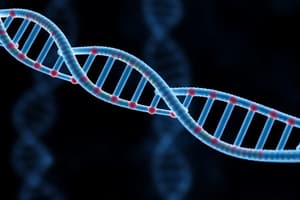Podcast
Questions and Answers
What is the primary enzyme responsible for processing the 5' ends of Okazaki fragments?
What is the primary enzyme responsible for processing the 5' ends of Okazaki fragments?
- RNA polymerase
- DNA helicase
- DNA polymerase I (correct)
- DNA ligase
Which DNA polymerase is responsible for synthesizing the leading strand?
Which DNA polymerase is responsible for synthesizing the leading strand?
- DNA polymerase III (correct)
- DNA polymerase IV
- DNA polymerase I
- DNA polymerase II
Where are Okazaki fragments synthesized in relation to the replication fork?
Where are Okazaki fragments synthesized in relation to the replication fork?
- At the center of the replication fork
- In the same direction as the replication fork
- They are not related to the replication fork
- In the opposite direction of the replication fork (correct)
What is the function of Okazaki fragments in DNA replication?
What is the function of Okazaki fragments in DNA replication?
Which enzyme is responsible for replicating the leading strand during DNA replication?
Which enzyme is responsible for replicating the leading strand during DNA replication?
At which point does DNA replication begin and where does the double helix separate into single strands?
At which point does DNA replication begin and where does the double helix separate into single strands?
How is the lagging strand synthesized in DNA replication?
How is the lagging strand synthesized in DNA replication?
Flashcards are hidden until you start studying
Study Notes
DNA Replication 101: Unraveling Okazaki Fragments, Leading Strands, and More
In the fascinating realm of biology, DNA replication is a process that ensures the accurate transmission of genetic information from one generation of cells to the next. As life's blueprint, DNA's intricate structure must be carefully copied. To help you grasp the core concepts, let's dive into key components of this essential process.
Okazaki Fragments
Okazaki fragments are short segments of DNA synthesized in the lagging strand. Unlike the leading strand, which is synthesized continuously, the lagging strand is replicated in a discontinuous manner, requiring the addition of Okazaki fragments. After replication, these fragments are connected to form a complete strand by the enzyme DNA ligase.
Leading Strand
The leading strand is synthesized in a continuous, 5' to 3' direction. This strand begins at the replication origin (where replication begins) and grows in the direction of the replication fork. The leading strand is replicated by the enzyme DNA polymerase III.
Replication Fork
The replication fork is the point at which DNA replication begins and where the double helix separates into single strands. The replication fork moves along the DNA helix in a 5' to 3' direction on both the leading and lagging strands.
Lagging Strand
The lagging strand is replicated discontinuously, meaning it is synthesized in short fragments called Okazaki fragments. These fragments are synthesized in the opposite direction of the replication fork and are later joined by DNA ligase to form a complete strand.
DNA Polymerase
DNA polymerase, a vital enzyme in DNA replication, is responsible for synthesizing new DNA strands by adding nucleotides in the 5' to 3' direction. DNA polymerase III is the primary enzyme that synthesizes the leading strand, while DNA polymerase I is responsible for processing the 5' ends of Okazaki fragments and filling in any gaps on the lagging strand.
Understanding DNA replication is crucial to the study of life and provides insight into the fundamental mechanisms that govern genetic inheritance and its implications in areas such as molecular biology, biotechnology, and medicine. As we continue to explore the intricacies of DNA replication, we gain valuable knowledge that paves the way for scientific advancement and discovery.
Studying That Suits You
Use AI to generate personalized quizzes and flashcards to suit your learning preferences.




